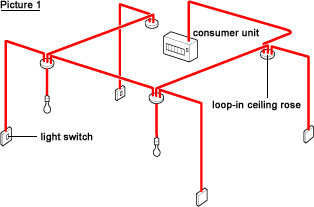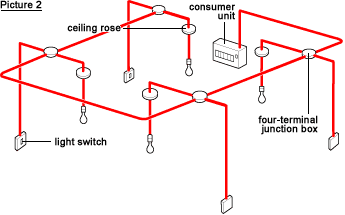A basic explanation of lighting wiring
Every lighting system needs a cable from the mains to supply power to all the lighting points and a switch that can interrupt the supply to each individual point.
Here we outline the two most common ways to meet that requirement - the loop-in wiring and the radial wiring (also referred to as 'junction box) installations.
Loop-in wiring
Picture 1 shows the basic principle of wiring a loop-in lighting system (the most modern/common).
The power from the mains consumer unit runs into each ceiling rose and out again, then on to the next ceiling rose.
The switch cable and the flex to the lighting fitting are connected at the ceiling rose - examples of the wiring found at ceiling roses on loop-in installations are given on this page - Loop-in circuits.
Radial (or junction box) wiring
 Picture 2 below shows a typical radial (or junction box) lighting system, a two-core and earth cable runs from the consumer unit to a series of junction boxes - one for each lighting point (ceiling rose). From each junction box a separate cable runs to the light and another runs to the switch. Whilst this system is rarely used now, it is much less complicated for the consumer to connect new light fittings. Examples of the wiring found at ceiling roses on radial/junction-box installations are given on this page - Radial circuits
Picture 2 below shows a typical radial (or junction box) lighting system, a two-core and earth cable runs from the consumer unit to a series of junction boxes - one for each lighting point (ceiling rose). From each junction box a separate cable runs to the light and another runs to the switch. Whilst this system is rarely used now, it is much less complicated for the consumer to connect new light fittings. Examples of the wiring found at ceiling roses on radial/junction-box installations are given on this page - Radial circuits

Replacing a light fitting is sometimes a simple task but other times it can be quite tricky. If you are in any doubt whatsoever you must get a qualified electrician in to do the job. It is better to be safe than sorry and it will be money well spent.
Under modern Part P Building Regulations, a householder can carryout a 'like for like' replacement or extend an existing lighting circuit providing that it is not within a kitchen or special area (defined as a room with a bath, shower basin, pool or sauna). Any addition or change within a kitchen or special area is notifiable or should be carried out by a suitably qualified person.
If you do intend to install the light fitting yourself; before touching the wiring, SWITCH OFF THE LIGHTING CIRCUIT AT THE CONSUMER UNIT. It would also be wise to let the people in the building know you are working on the electrics and to hang something on the consumer unit to remind them that the circuit is switched off for a reason.
Study your fitting instructions but if they don't help much follow the guidelines outlined here:
VERY USEFUL TIP!!
The best way to ensure you don't make a mistake when reconnecting wiring is to make a sketch of the terminals with the existing wires attached BEFORE you disconnect them and AFTER you've switched off the circuit. Taking two minutes to make a quick sketch will make the task of reconnection a lot safer and easier - marking the individual cable with different number of dots using a 'magic marker' can also help.
The examples shown in the 'loop-in system' and 'radial system' sections cover the most likely combinations of wiring you will find when you remove ceiling fittings. Pictures 1A - 6A show the wires in a ceiling rose and pictures 1B - 6B show what you must do with those wires if you have to disconnect them from the ceiling rose in order to fit your new light.
Having switched off the electricity at the mains and removed the old light fitting, take a close look at the wiring arrangement and compare it with the examples shown here. If you make a sketch, check it carefully and you won't need to refer to the diagrams below.
IMPORTANT NOTE
It is general practice for electricians to 'tag' the switch live (normally a black sleeved core) with a piece of red insulation tape. Unfortunately not all electricians do what they are suppose to do and the switch live may not be identifiable in this way. Should you find this is the case, don't take chances - call in an electrician.
OLD WIRING
If you should ever come across old fabric covered wiring (usually twisted in pattern), or rubber insulated wiring, you will almost certainly have to replace it - it is unsafe. It will almost certainly have no earth wires present. We strongly advise you to consult an electrician to check the system out before you commence work.
(originally on, and copyright of, userview.net)
